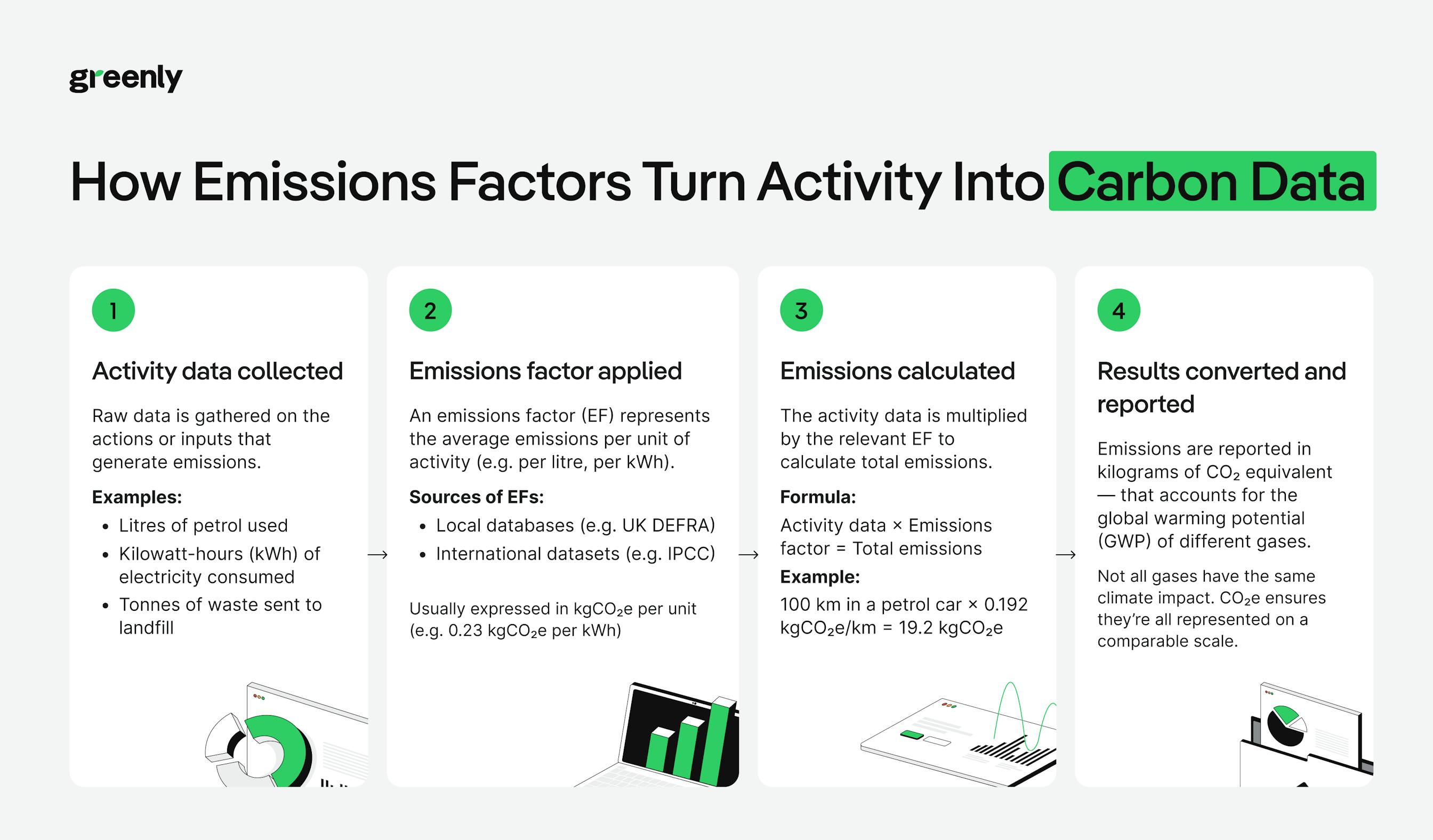
California Climate Accountability Package: SB253, SB261, & SB252
What is the California Climate Accountability Package, and how do SB 253 and SB 261 (SB 219), and SB 252 help the state work towards their environmental goals?
ESG / CSR
Industries



What emission factors are and how they work
The ups and downs of using emission factors
How to properly calculate emission factors
Between seeking to reduce your carbon emissions, engage with your suppliers, and keep track of your finances – today’s economy and changing market requires companies to exhibit greater efforts towards sustainability, including calculating various components such as an emission factor.
An emission factor refers to the numerical value which is bound to represent the amount of a predetermined pollutant or a greenhouse gas in the atmosphere in relation to the activity in which it was created by.
Why is it imperative for your company to have a good grasp on the importance of an emission factor?
In this article, we’ll explain what an emission factor is, some examples of an emission factor, why they are important, and how your company can calculate an emission factor.
An emission factor is the numerical representation of how much carbon dioxide, methane, or greenhouse gasses are emitted into the atmosphere due to a specific activity.
As a result, an emission factor has been used as a way to help people more easily understand the environmental impact and activity or product created on the planet – such as with round trip plane rides or the average carbon footprint of a holiday dinner.
Emission factors are usually expressed in kilograms, metric tons, or pounds per unit of energy, activity or material used.
An emission factor is used for multi-various reasons, such as for the following:
It is important to remember that emission factors may vary depending on various circumstances, such as the technology used to calculate emission factors, business operations, and geographic location – which makes it important to ensure all calculations on emission factors are as accurate as possible to ensure fair creation of environmental policies.

An emission factor is vital to society, especially in the midst of climate change, as it can help provide necessary insight to help in sustainable development, ethical business practices, and even help to develop new climate or environmental policy.
Think of when shopping for the best deal on a new product. This usually means searching for the best quality without needing to spend too much money. The only reason money is involved in the decision is because society has given the product a numerical value. The same goes for emissions created, seeing as an emission factor has provided society with a quantifiable target to create and work towards goals against.
Here are some more reasons as to why emission factors are important:
Emission factors already helped to develop new environmental regulations, but how can others make sure that those required to oblige to the regulations are actually meeting the demands? This is done with emission factors, as they serve as a tool to help calculate and share the emissions data of a company or organization.
The AQI (AQI) cannot find ways to improve without a baseline of information. This is precisely where emission factors come in, as they are necessary in order to fully understand and measure the impact that industry activities and every day transportation has on our air quality. Without emission factors, it would be more difficult to set concrete targets to improve the Air Quality Index.
Think of someone determined to lose weight. Odds are, they have a goal weight in mind – and aren’t working aimlessly towards a random number. The same concept goes for reducing emissions – whether it be worldwide or within a company. Emission factors provide us with numerical meaning to help monitor, measure, and assess our progress in reducing our carbon footprint and reaching our goals.
The numerical data provided on behalf of emission factors directly help both scientists and researchers to develop stronger environmental models, which can overall sway businesses, governments, and even entire countries to change their approach to climate change and reduce emissions.
We know the phrase usually goes, “a picture says a thousand words”, but in this case – the information provided by emission factors is much more likely to speak volumes to society as opposed to a one picture from a single natural disaster. Therefore, emission factors are important as they help to spread the word on the importance of reducing our environmental impact.
Standardized emission factors let companies and sectors compare performance on equal footing, identify leaders and laggards, and prioritize the biggest opportunities for reduction.
Overall, it is important to realize that the main benefit of emissions factors is that they quantify the impacted created by various pollutants and activities – which is vital to fuel the world and provide incentives to reduce emissions as a whole.

Some common examples of emission factors include carbon dioxide (CO₂), greenhouse gasses (GHG), methane (CH₄), and other volatile organic compounds.
Here is a breakdown of some of the most common emission factors used in society to help standardize the information associated with environmental impacts:

The electricity emission factors by country as of 2025 are as follows, expressed in carbon dioxide emission factors:
Ultimately, without emission factors – it would be difficult to communicate basic information such as the top emitting countries in the world, seeing as emission factors provides a standardized unit that anyone can understand.
Calculating an emission factor is dependent on the type of emission you are trying to calculate.
However, many are able to use the following formula when seeking to calculate an emission factor:
Emission Factor (EF) = Total Emissions / Total Activity
EF = (Total emissions of the pollutant) / (Total amount of activity)
The vertical timeline below will break down how to calculate an EF:
Clearly describe what you’re measuring (e.g., liters of diesel burned, kWh of electricity used, kilometers driven). This “activity data” will be the denominator in your emission factor formula.
Gather accurate totals for the activity over a chosen period (month, year, project). For example, sum all fuel receipts, energy bills, or production logs to find the Total Activity.
Measure how much of the pollutant was released during that same period (e.g., kilograms of CO₂, CH₄, or NOx). This can come from direct monitoring, lab analysis, or trusted published factors. This gives you the Total Emissions.
Make sure the units match and cover the same timeframe. If activity is in liters of fuel per year, emissions should also be for that same year and converted to consistent units (e.g., kilograms of pollutant).
Use the core calculation:
Emission Factor (EF) = Total Emissions / Total Activity
or written explicitly:
EF = (Total emissions of the pollutant) / (Total amount of activity).
Divide your measured emissions by the total activity to obtain an EF, such as
“kg CO₂ per liter of diesel” or “g CH₄ per km driven.”
Multiply this emission factor by new activity data to estimate future emissions, compare performance between sites or products, or identify hotspots where reductions will have the biggest impact.
Periodically repeat the calculation with fresher data, better monitoring, or improved methods. Refining the emission factor over time makes your carbon accounting more accurate and your reduction strategies more effective.
Below is a demonstration of someone calculating the emission factor for greenhouse gas emissions:
Some of the challenges presented with emission factors include difficulties with new technologies and varied estimates, confidentiality, and an overall lack of standardization.
Think of the SAT or ACT standardized tests, used to help students get into college in the United States. If these tests didn’t exist, colleges would have to use student’s grade point averages (GPA) as the sole numerical measure to determine if they are worthy of attending their school.
However, this is unfair seeing as the level of rigor at high schools are bound to vary across the country – demonstrating why the need for standardization is pivotal for emission factors, too.
The infographic below will further breakdown some of the challenges of turning emission factors into usable carbon data:


Here are some more challenges often presented with emissions factors:
Despite these challenges, efforts are still being made to improve emissions factors and ensure it remains a viable resources for all industries seeking to use them.

At the end of the day, emission factors still offer an indispensable benefit – which is being able to quantify the impact created by various emissions through industrial processes, activities, energy production, transportation, and more.
While the system of emission factors may not be 100%, the system we currently use is worth keeping intact in order to numerically depict and better understand the way our everyday activities continue to have a profound effect on the planet.
The interactive flip cards (move cursor over card to flip) will reveal why emission factors are worth using despite their potential challenges:
If reading this article on emission factors has made you interested in reducing your carbon emissions to further fight against climate change – Greenly can help you!
Keeping track of how an emission factor could impact your business can be confusing, but don’t worry – Greenly is here to help! Click here to schedule a demo to see how Greenly can help you comply with all of the upcoming regulations relevant to your company.
Greenly can help you make an environmental change for the better, starting with a carbon footprint assessment to know how much carbon emissions your company produces.